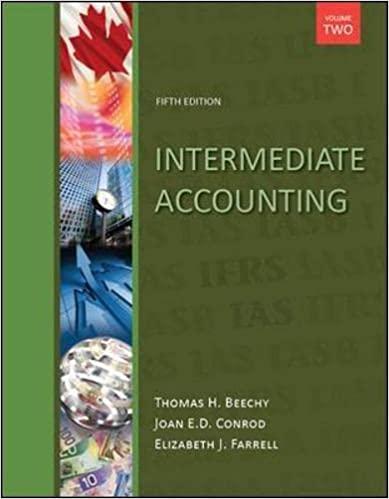Drugstore Depot Limited (DDL) is a diversified Canadian company whose key businesses include retailing of drug store
Question:
Drugstore Depot Limited (DDL) is a diversified Canadian company whose key businesses include retailing of drug store and food products, and real estate interests. Real estate is primarily held for DDL occupancy, although where DDL retail operations are an anchor tenant in a smaller mall, DDL prefers to own the commercial real estate property and act as landlord to other tenants. The company is public, with both debt and shares traded on public markets. Common shares traded in the \(\$ 8-\$ 14\) range in \(20 \times 2\).
DDL labels gains on sale of real estate as "capital gains" on the statement of comprehensive income. The term is not used in its income tax context; it is just a term assigned to a "gain on sale." The company regularly calculates and disseminates information on basic and diluted EPS numbers, before and after capital gains and income tax. Company management prefers to focus on results before capital gains and income tax when communicating to shareholders, because gains from sale of real estate are sporadic, and business units have operating targets on a pre-tax basis. In 20X1, the company recorded earnings before capital gains and income tax of \(\$ 5.60\) per share, and diluted EPS before capital gains and income tax of \(\$ 5.56\). After capital gains and income tax, the numbers were \(\$ 5.03\) and \(\$ 4.99\).
You are an accountant in the corporate reporting department of DDL. Financial statements are in the process of being finalized for the 20X2 fiscal year, which ended on 31 December 20X2. The audit committee will meet next week, with several accounting policy issues left to resolve. EPS calculations must also be completed.
Effective 31 December 20X2, DDL sold certain real estate properties to Dixon Real Estate Investment Trust (Dixon REIT). The properties had a book value of \(\$ 239\) million, and were sold for \(\$ 374\) million gross cash proceeds. In addition, DDL received units in Dixon REIT estimated to be worth \(\$ 50\) million. There were brokerage and legal costs of \(\$ 7\) million associated with the sale. Income tax triggered by the sale amounted to \(\$ 27\) million in current taxes payable, and another \(\$ 4\) million in deferred income tax. The transfer has yet to be reflected in the 20X2 financial statements. As part of the transaction, DDL entered into new lease agreements with respect to its occupancy in a portion of the real estate properties now owned by Dixon REIT. The leases have an expected total term of between 17 and 23 years; initial lease arrangements are established for five years, followed by renewal periods to the end of the term. Minimum rents range from \(\$ 8\) to \(\$ 14\) per square foot, plus a percentage of gross revenue, and there are planned base rental increases every five years.
In the late fall of \(20 \times 2\), one major real estate property owned by DDL burned to the ground. DDL was the sole occupant of this building, which had a book value of \(\$ 17\) million. Inventory with a book value of \(\$ 7.2\) million was destroyed in the fire. Investigation into the cause of the fire, thought to be electrical in nature, is under way. DDL carries property and casualty insurance, and has filed a claim for \(\$ 32.2\) million, allocated \(\$ 25\) million to the building, and \(\$ 7.2\) million for inventory. Income tax triggered by the insurance proceeds has been estimated to be \(\$ 1.4\) million in current taxes payable, and another \(\$ 0.7\) million in deferred income tax. Lawyers for DDL believe that DDL is entitled to insurance recovery for the fair value of the property and inventory destroyed, in excess of the \(\$ 1\) million deductable under the policy. Accordingly, the expected payout is \(\$ 31.2\) million. A team of insurance adjustors is assessing the situation. The fire investigators and the insurance adjustors have yet to file their reports. The property and inventory remain on DDL's books in the meantime.
DDL entered into a five-year referral contract during the year. Physiotherapy and chiropractic services represent a large and growing market in Canada, and pharmacists in DDL stores are often consulted by customers about appropriate action. Any retail customer who requests physiotherapy and chiropractic advice or services in a DDL store will be referred to Nature Force Limited, a national chain that is the Canadian leader in such services. The agreement specifies that DDL will be paid \(\$ 1\) million minimum the first year of the agreement, or \(30 \%\) of client billings resulting from referrals, whichever is higher. Revenues in the second year are \(30 \%\) of billings, with no minimum, and then the percentage reduces from \(30 \%\) to \(25 \%\), then \(20 \%\) and \(15 \%\) over the remaining three years of the contact. After the first year, either side can end the agreement with 60 days' notice. An appropriate information system has been established to ascertain the extent of billings Nature Force realizes from the referrals, subject to external verification.
To date, Nature Force has not made any payment to DDL for Year 1 minimum payment, because the amount is not due until the 12 -month anniversary of the agreement, which occurs in October 20X3. No revenue has been recorded by DDL in the \(20 \mathrm{X} 2\) financial statements. The pharmacists report that referrals have been "quite strong," although there are regional differences.
Required:
In preparation for the coming audit committee meeting, prepare a report that includes analysis of the accounting issues inherent in the transactions above, and any other reporting issues. Recalculate net earnings, if appropriate, and prepare EPS calculations for \(20 \mathrm{X} 2\).
Step by Step Answer:






